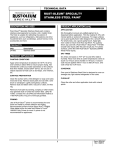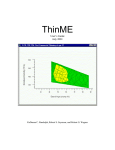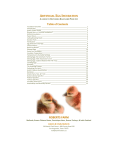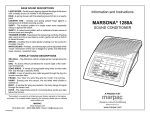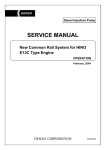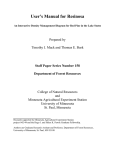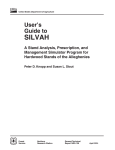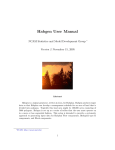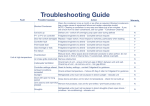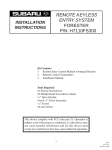Download P2832 Thinning Pine Trees by the Leave Tree Method
Transcript
Thinning Pine Trees by the Leave Tree Method At some point after establishment, both natural and planted pine stands in the South need thinning at some point as tree crowns grow together and trees start to compete with one another. Thinning removes trees of lower quality and/or vigor, increasing the overall health and quality of the residual stand. Images of evenly spaced rows of similarly sized trees come to mind when most people think of pine plantations. However, in reality, many planted stands across the state have a significant number of volunteer stems growing among those that were planted. These additional stems in plantations, as well as the large number often found in natural stands, can provide extra challenges when attempting to reduce stand densities to appropriate levels. While not always the case, current thinning techniques, rules, and systems may be overly complicated for some private landowners. Extensive testing by the USDA Forest Service under actual sale conditions has shown that leave tree thinning in overstocked pine stands results in a more consistent silvicultural treatment and higher yields per acre than other methods. The relative simplicity of the leave tree method makes it applicable on private timberlands by nonforesters. This publication details the method known as “leave tree marking,” named so because you mark trees that you are going to “leave.” The method is different from the more widely used selective marking technique. With selective marking, the poorest-quality, diseased trees and trees that are undesirable to the goals of ownership are selectively marked to be cut. Leave tree marking is used in early thinnings to leave the best potential crop trees. The method is especially applicable in young, dense stands where more trees are to be cut than left. After the first or second thinning, you can switch to selective marking because fewer trees will be cut than left. Selective marking is used in these later thinnings to remove poorer-quality trees. Both methods are used to achieve the same end results—removing poor trees and retaining the highest-quality trees. Regardless of which marking technique you use, make sure the method used is written into the cutting contract between the landowner and contractor. Additionally, be positive that the logging crew is aware of which marking technique was used. For information on how to include marking technique in your cutting contract, see Mississippi State University Extension Service Management Technical Note 19F Sample Thinning Contract. With a little training and experience using the leave tree method, you can choose the best tree in a small area and leave it marked as a future crop tree. An additional item to consider when using any thinning method in a first thinning is the issue of access. The overall high densities encountered in both natural stands and plantations dictate the removal of “corridors,” or rows of trees, so that equipment may access the remainder of the stand. In stands that have been naturally regenerated, cutting corridors should be flagged or marked so that logging crews may remove the trees within them. The width and direction of corridors will depend on several factors, including the size of logging equipment to be used, topography, the per-acre density desired for the residual stand, and your management goals. Cutting for equipment access in plantations is a somewhat easier process. Row thinning is used to provide the needed space for logging equipment. The process involves removing entire rows of trees, typically every third or fourth row. This provides access for logging crews to remove unmarked trees from the other rows within the plantation. Whether you are using corridors or removing rows, make sure not to mark leave trees in these areas. Remember, every tree within these areas will be removed. Some of the technical terms used in this publication may be unfamiliar. If you have questions regarding their use, please consult Extension Publication 1250 Forestry Terms for Mississippi Landowners. Figure 1. DBH measurement. (Photo by Adam Rohnke) Advantages of Leave Tree Marking Basic Steps in Leave Tree Marking • Nonforesters more easily understand the concept of leave tree marking. • It may minimize marking costs because less paint and labor is used to mark leave trees than to mark cut trees in high-density stands. • It is easier to see the spacing and quality of the remaining crop trees before the stand is thinned. • It typically results in more uniform thinnings. • Cut marked trees are easy to spot at the loading deck, and stumps marked with paint provide evidence of improper tree removal. These are the five basic steps to the leave tree method: 1. Determine the “prevailing diameter” of leave trees in the stand. 2. Use the prevailing diameter to select the proper spacing. 3. Determine the proper spacing. 4. Select and mark leave trees. 5. Navigate through the stand. Determine the Prevailing Diameter The prevailing diameter is simply the average diameter class of the acceptable leave trees most common in the stand of interest. It is not the average diameter in the stand, but rather the average diameter of the trees you want to leave. Prevailing leave tree DBH can be determined using a tally of selected trees taken at periodic sample points along cruise lines throughout the stand. A cruise line is an imaginary line or path that crosses the planted rows or the slopes at right angles. Cruise lines are placed so that the DBH of acceptable leave trees will be adequately sampled. Plot sampling can also be used, but this is a more complicated process that a consultant would typically use. Cruise lines should cross planted rows and topographic changes at right angles. The lines should be about 150 feet apart in smaller stands of just a few acres and about 300 feet apart in large stands. At predetermined distances along the cruise lines (for example, every 50 to 100 feet), measure the DBH of the nearest acceptable leave tree. At each sample point, select the nearest dominant or co-dominant tree acceptable as a leave tree, and record its DBH. When stand sampling is completed, the diameter class most frequently represented in the tally is the prevailing DBH of leave trees. Tally the trees according Disadvantages of Leave Tree Marking • Logging crews unfamiliar with the technique may cut the wrong trees without thorough instruction. • Marking costs may be greater in second or third thinnings because there will probably be more leave trees than take trees. How to Measure Tree Diameter Tree diameter must be used to determine proper tree spacing. Tree diameter is measured at 4½ feet above the ground. Measurements at this height are called diameter at breast height, or DBH. DBH can be measured with a steel diameter tape or a Biltmore stick. The Biltmore stick is quick and easy to use but is not as accurate or consistent as a diameter tape. For information on how to construct or obtain a Biltmore stick and on proper DBH measurement techniques, consult your Extension forestry specialist, or read Extension Publication 1473 4-H Project No. 7: Measuring Standing Sawtimber. 2 it also gets larger in crown diameter and needs more growing space. Tree spacing controls diameter growth, so if your goal is to produce large sawtimber trees as quickly as possible, you need to thin every 5 to 10 years to optimize increased diameter growth. Remember, the numbers below are averages and will vary across the stand. The expectation is not to achieve exact tree spacing or numbers, but to perform a thinning with trees spaced near the spacing values listed below. to their diameter to the nearest inch. Determining the proper DBH is important because the prevailing DBH of the leave trees is used to select the proper spacing. Use the Spacing Table It is best to use the age and site index of the stand to select the spacing because this will result in complete site utilization for optimum growth and yield. However, if stand age and site index are not known, a reasonable spacing can be obtained using Table 1 for loblolly pine with only prevailing leave tree DBH. Table 1 is used to determine how many trees to leave per acre and the desired spacing of leave trees for average-, low-, and high-quality sites. An example of how to use the table is as follows: If the prevailing DBH is 8 inches, look within the row for 8-inch trees. In this case, leave trees should be spaced 15 feet apart on low-quality sites, 14 feet apart on average sites, and 13 feet apart on high-quality sites. On average sites, about 222 trees per acre will be left using this spacing. If you are familiar with measuring basal area, an average site “rule-of-thumb” basal area target is the same as site index for the stand. Notice across the same row that for a given DBH, more trees per acre are left on higher-quality sites than on those of lower quality. A higher-quality site has more productive soil and can support more trees than a lower-quality site. Now look at the potential for site productivity (trees/acre) down the same column; fewer leave trees are required per-acre for larger diameters than for smaller diameters. As a tree gets larger in diameter, Lay off the Spacing Grid For the sake of discussion, assume you have determined a desired spacing of 15 feet in your pine stand. Next, you must divide the stand into a grid of imaginary squares, each measuring 15 feet on each side. It is not necessary to actually mark and/ or flag these squares before marking leave trees. The grid system is just a simple way to understand the method and get you started. A compass will help you walk straight lines and keep squares in their proper locations, but you can use a string as a guide as you gain navigating experience. Aerial photographs and maps can be used to check your progress as you move through the stand. A series of compass lines, 15 feet apart in this instance, will be used to guide you through the stand as you mark leave trees. You may want to tie flagging along your compass lines as you move through the stand. Vinyl flagging provides an easy visual reference point to follow as you travel back and forth through the plantation marking trees. Table 1. Spacing by prevailing leave tree DBH and site quality.* DBH (inches) Low-quality site BA 70 (trees/acre) Spacing (feet) Average site BA 80 (trees/acre) Spacing (feet) High-quality site BA 90 (trees/acre) Spacing (feet) 6 360 11 x 11 436 10 x 10 436 10 x 10 7 258 13 x 13 303 12 x 12 360 11 x 11 8 194 15 x 15 222 14 x 14 258 13 x 13 9 151 17 x 17 170 16 x 16 194 15 x 15 10 134 18 x 18 151 17 x 17 170 16 x 16 11 109 20 x 20 121 19 x 19 134 18 x 18 12 90 22 x 22 99 21 x 21 121 19 x 19 13 76 24 x 24 90 22 x 22 99 21 x 21 *Adapted from USDA Forest Service Manual for the Kisatchie National Forest, Louisiana. 3 If you choose to flag your compass lines, make sure that you maintain straight lines by turning around and checking for linear accuracy. Each line will run through the center of a row of the imaginary squares. Begin your first compass line half of the spacing distance into the edge of the pine stand (7½ feet in this case). For example, if you begin at the southeast corner of the stand, your first compass line should begin 7½ feet from the south and 7½ feet from the east stand boundaries. This will place you in the center of your first imaginary 15- by 15-foot square. You can use a measuring or logger’s tape to help you judge the size of the square. Select and Mark the Leave Trees The purpose of this step is to select the highestquality tree within the square. Be sure to inspect all trees within the square, including all four corners. Only one tree should be selected, and it can be located anywhere within the square’s boundaries. An acceptable leave tree should be free of disease and relatively straight, and have a well-formed, full crown in the main canopy layer or above the crowns of surrounding trees. Remember, your intent is to leave the best trees and cut those of lower quality. If two or more trees are equally acceptable, the tree nearest to the center of the grid should be selected. If no “good” tree is present, a less desirable tree (forked, crooked, small, etc.) may be used in the square rather than leaving the area empty. Again, choose the best tree available in each given square. After selecting the tree you plan to leave, mark it with paint using a large slash at eye level and at ground level on the stump. Consider logging direction, and make eye level marks facing the expected cutting direction. Figure 2. Compass lines marking access corridor. (Photo by James Floyd) Make sure to use paint generously so that loggers can see this is a marked leave tree. The stump mark is extremely important because it will likely serve as the only evidence that the tree was marked in the event of improper cutting. Use a good-quality tree marking paint with lasting power. Figure 3. Sample layout of spacing grid. 4 After Marking Is Complete Leave tree marking is not difficult, but, upon completion, you should check your work for largescale mistakes. Take time to walk back through the stand and observe the spacing of leave trees. The paint marks let you see what the stand will look like after it has been thinned. Now is the time to catch any major errors. Once the stand is thinned, any unchecked mistakes may be irreversible. The next time you thin, you will need to use a different color paint to differentiate leave trees from those to be cut. Figure 4. Marked trees. (Photo by Adam Rohnke) Navigate through the Stand After you have successfully found and marked the leave tree in your first square, use your compass and measuring tape to help you move from the center of the first square to the center of the next, or you can pace the distance if you are familiar with your pace length. Mark the best tree in that square and keep going. Once you have reached the opposite side of the stand, move over the full spacing distance (15 feet in this example) and start a new line parallel to the first. Continue back and forth until you have covered the entire stand. You may find it helpful to use two measuring tapes to achieve the desired spacing distance. A tape will also help you visualize boundaries of the square. Lay one tape down along your compass line and place the other perpendicular to the first. The crossing point of the tapes is the center of the square. You can use this method until you have mastered judging the correct distance between square centers and their boundaries. As you gain experience selecting trees and judging proper spacing distance, you will find that you can navigate and mark leave trees very close to the desired spacing, using compass lines and grid squares occasionally as a check. Figure 5. Unmarked trees being removed. (Photo by James Floyd) The condition of your stand will be much improved after thinning, and you can take pride that you have marked it yourself. You have not only increased the diameter growth of residual trees, but you have also reduced the chances of damage from pine beetles and disease. Additionally, trees that would not have survived until the next logging reentry have been removed, capturing revenue that would have been lost if the stand were left unthinned. Thinning does have some risks. You might lose a few skinned or damaged trees to various environmental factors. Additionally, there is a greater 5 Additional Reading risk of storm/ice damage in recently thinned stands. However, the risk of losing a few trees to thinning is greatly offset when considering the much greater health and economic risks involved with leaving a stand unthinned. For more information detailing the dangers of leaving a pine stand unthinned, see Extension Publication 2732 Protect Your Pine Plantation Investment by Thinning. If you are uncomfortable marking your pine stand for thinning, consulting foresters can also help you on a commission or fee basis. Contact information for consulting foresters can be obtained at www.cfr. msstate.edu/borf. You can search by county, city, or the forester’s last name. Foresters on this list must be registered with the state, which sets standards for their credentials. For information on selecting a forestry consultant, read Extension Publication 2718 Choosing a Consulting Forester. For more information and publications about leave tree marking and other thinning techniques, contact your area Extension forestry specialist or Mississippi Forestry Commission county service forester. The Mississippi State University Extension Service also has various publications to help you manage your timber. These can be found at www.msucares.com, or you can contact your county Extension agent for more information. Remember, when considering a thin in your pine stand, either thin on your terms, or Mother Nature will do it on hers. Timothy Traugott and Stephen Dicke. 2006. Are My Pine Trees Ready To Thin? P2260. Mississippi State University Extension Service. James Henderson and Andrew Londo. 2012. Protect Your Pine Plantation by Thinning P2732. Mississippi State University Extension Service. John Kushla and Andrew Londo. Forestry Terms for Mississippi Landowners P1250. Mississippi State University Extension Service Jason Gordon. 2012. Choosing a Consulting Forester P2718. Mississippi State University Extension Service. Jason Gordon. 4H Project No. 7: Measuring Standing Sawtimber P1473. Mississippi State University Extension Service. Timothy Traugott and Stephen Dicke. 2006. Sample Pine Thinning Contract MTN 19F. Mississippi State University Extension Service. Figure 6. Completed thin. (Photo by James Floyd) 6 Copyright 2014 by Mississippi State University. All rights reserved. This publication may be copied and distributed without alteration for nonprofit educational purposes provided that credit is given to the Mississippi State University Extension Service. By Andrew B. Self, Assistant Extension Professor, and Robert C. Parker, former Professor, Forestry. Discrimination based upon race, color, religion, sex, national origin, age, disability, or veteran’s status is a violation of federal and state law and MSU policy and will not be tolerated. Discrimination based upon sexual orientation or group affiliation is a violation of MSU policy and will not be tolerated. Publication 2832 Extension Service of Mississippi State University, cooperating with U.S. Department of Agriculture. Published in furtherance of Acts of Congress, May 8 and June 30, 1914. GARY B. JACKSON, Director (POD-04-14)







